 Last additions Last additions |

Daibansho Guardhouse 大番所Mar 28, 2007
|
|

Side view of castle tower foundation.Mar 28, 2007
|
|

Corner of castle tower foundation.Mar 28, 2007
|
|

View of Kitahanebashi-mon GateMar 28, 2007
|
|

Top of castle tower foundation.Mar 28, 2007
|
|

Mar 28, 2007
|
|

Going up the castle tower foundation.Mar 28, 2007
|
|

Mar 28, 2007
|
|

Mar 28, 2007
|
|

Mar 28, 2007
|
|

Moat behind castle tower foundation.Mar 28, 2007
|
|

Mar 28, 2007
|
|

Going up the castle tower foundation.Mar 28, 2007
|
|

Mar 28, 2007
|
|

Mar 28, 2007
|
|

Castle tower's foundation on the lower right.Mar 28, 2007
|
|

Honmaru, Edo Castle's main keep. See the castle tower's foundation on the lower right. 本丸Mar 28, 2007
|
|

Mar 28, 2007
|
|

View from castle tower foundation.Mar 28, 2007
|
|

The original castle tower or donjon was completed in 1607 and later renovated in 1638 under Shogun Tokugawa Iemitsu as Japan's tallest castle tower at 58 meters (5 stories high).Mar 28, 2007
|
|

Behind Fujimi TurretMar 28, 2007
|
|

Behind Fujimi Turret 富士見櫓Mar 28, 2007
|
|

Mar 28, 2007
|
|

Foundation of castle tower or donjon. In 1657, there was a great fire in Edo and a stray ember set the castle tower on fire and destroyed it only 19 years after it was built. It was never rebuilt. 天守台Mar 28, 2007
|
|

Fujimi Turret 富士見櫓Mar 28, 2007
|
|

MoatMar 28, 2007
|
|

Mar 28, 2007
|
|

Mar 28, 2007
|
|

Fujimi Turret 富士見櫓Mar 28, 2007
|
|

Map of the East Gardens of the Imperial PalaceMar 28, 2007
|
|

Mar 28, 2007
|
|

Mar 28, 2007
|
|

Fujimi Turret 富士見櫓Mar 28, 2007
|
|

Fujimi Turret, Edo Castle 富士見櫓Mar 28, 2007
|
|

Fujimi Turret 富士見櫓Mar 28, 2007
|
|

MoatMar 28, 2007
|
|

Fujimi Turret 富士見櫓Mar 28, 2007
|
|

At one end of the Chowaden is Kitakuruma-yose entrance for Japanese dignitaries. 北車寄Mar 28, 2007
|
|

Fujimi Turret. Since Edo Castle had lost its castle tower which was never rebuilt, this turret served the functions of a castle tower. 富士見櫓Mar 28, 2007
|
|

Imperial Household Agency is the government agency which controls and manages the affairs of the Imperial family (Emperor, Empress, etc.). 宮内庁Mar 28, 2007
|
|

Mar 28, 2007
|
|
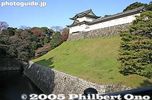
Fushimi Turret. This is what you see when you see Nijubashi Bridge. No one lives in this building. The Emperor's actual residence is not visible from the outside. 伏見櫓Mar 28, 2007
|
|

Fujimi Turret 富士見櫓Mar 28, 2007
|
|

Mar 28, 2007
|
|

Japanese flag and Fujimi TurretMar 28, 2007
|
|
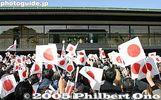
The Emperor and Empress appear on the veranda of this building on his birthday (Dec. 23) and Jan. 2. Well-wishers wave flags in the Kyuden Totei plaza. Also see the video at YouTube.Mar 28, 2007
|
|

Crown Prince Hiro, Emperor Akihito, and Empress Michiko behind bulletproof glass on the veranda of the Chowaden Hall on the Emperor's Birthday. See more [url=http://photoguide.jp/pix/thumbnails.php?album=158]photos of the Emperor's birthday[/urlMar 28, 2007
|
|

The Imperial Palace's Chowaden Hall where formal banquets and meetings are held. This modern complex was built in 1968. In front is the Kyuden Totei plaza 長和殿、宮殿 東庭Mar 28, 2007
|
|

Nijubashi Bridge, the symbol of the Imperial Palace and Tokyo. One of Japan's most famous bridges. There is another bridge behind this one. 二重橋Mar 28, 2007
|
|

Fushimi Turret as seen from Nijubashi Bridge. Edo Castle was first built by Ota Dokan (太田道灌) in 1457 when Tokyo/Edo was still a small fishing village. Ota Dokan is thus regarded as one of Tokyo's forefathers. 伏見櫓Mar 28, 2007
|
|

Crossing Nijubashi Bridge to enter the Seimon Gate. 正門Mar 28, 2007
|
|

View from Nijubashi Bridge. The public can cross the bridge on the Emperor's Birthday (Dec. 23) and Jan. 2 for New Year's.Mar 28, 2007
|
|

In Japanese, the Imperial Palace is called "Kokyo" (皇居). This term begun to be used from 1948. Until then, it was called "Kyujo" (meaning palace castle 宮城)from the time Emperor Meiji took up residence.Mar 28, 2007
|
|

Guarded entrance to National DietMar 27, 2007
|
|

Throne used by the Emperor in the National Diet during the Meiji Period. 御椅子Mar 27, 2007
|
|

Diet pins. Photography is not allowed inside the building outside this lobby.Mar 27, 2007
|
|

Signboard for noblesMar 27, 2007
|
|

Ballot box and ballot slips. 投票箱・木札Mar 27, 2007
|
|

The free tour starts by going down to the House of Councillors Visitors' Lobby.Mar 27, 2007
|
|

Sample of various stones used in the building. As much as possible, domestic materials were used in the construction.Mar 27, 2007
|
|

House of Councillors Visitors' Lobby. Various exhibits are here. 参観ロビーMar 27, 2007
|
|

Inside the Central Tower. Stained glass and murals depicting the four seasons.Mar 27, 2007
|
|

Central TowerMar 27, 2007
|
|

The National Diet is Japan's political and legislative center. The capital of Japan. Free 60-min. tours (in Japanese only) are conducted every hour every day when the Diet is not in session.You can see the House of Councillors (Sangiin), the central tower, and the Emperor's Room.Mar 27, 2007
|
|

Side view of the House of Councillors (Sangi-in).Mar 27, 2007
|
|

On the right is the House of Councillors (Sangi-in). 参議院Mar 27, 2007
|
|

The National Diet building (Kokkai Gijido in Japanese) was built in Nov. 1936 after 17 years of construction. 国会議事堂Mar 27, 2007
|
|

The building is perfectly symmetrical on the left and right. On the left is the House of Representatives (Shugiin). 衆議院Mar 27, 2007
|
|

The Central Tower is 9 stories high. Below it is the Central Entrance whose bronze doors are opened only for the Emperor of Japan, State Guests, and new Diet members on the first day of a Diet session.Mar 27, 2007
|
|

National Diet of Japan 国会議事堂Mar 27, 2007
|
|

Someone injuredMar 25, 2007
|
|

Urawa-misono Station with soccer fans going home. Also see the video at YouTube.Mar 25, 2007
|
|

Good saveMar 25, 2007
|
|

Mar 25, 2007
|
|

Getting nearer to the train station.Mar 25, 2007
|
|

Crowd heading for Urawa-misono Station on the Sai-no-Kuni Stadium Line. It was a stop and go process.Mar 25, 2007
|
|

Sea of RedMar 25, 2007
|
|

Mar 25, 2007
|
|

Mar 25, 2007
|
|

Mar 25, 2007
|
|

Mar 25, 2007
|
|

Mar 25, 2007
|
|

Manchester United vs. Urawa RedsMar 25, 2007
|
|

Attendance numberMar 25, 2007
|
|
|
|

Mar 25, 2007
|
|

Mar 25, 2007
|
|

Mar 25, 2007
|
|

Mar 25, 2007
|
|

Saitama Stadium 2002Mar 25, 2007
|
|

Saitama Stadium is a large soccer stadium built for the Soccer World Cup in 2002 and now home of the Urawa Reds. Way to Saitama Stadium 2002 from the train station.Mar 25, 2007
|
|

Stadium entryMar 25, 2007
|
|

Vodafone Cup with the Urawa Reds vs. Manchester United on July 30, 2005.Mar 25, 2007
|
|

These photos were taken during the Vodafone Cup with the Urawa Reds vs. Manchester United on July 30, 2005. Over 58,000 fans attended. Mar 25, 2007
|
|

Mar 25, 2007
|
|

Mar 25, 2007
|
|
|
|

Mar 25, 2007
|
|

Very popular festival and well-worth seeing.Mar 25, 2007
|
|

Mar 25, 2007
|
|

Mar 25, 2007
|
|

Mar 25, 2007
|
|

Smoking dragon danceMar 25, 2007
|
|

Mar 25, 2007
|
|

Dancing in front of JR Shinjuku Station, East sideMar 25, 2007
|
|
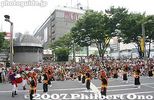
Mar 25, 2007
|
|

Mar 25, 2007
|
|

Hand drumMar 25, 2007
|
|

Mar 25, 2007
|
|

Infectious Okinawan beat. Shinjuku Eisa Matsuri, TokyoMar 25, 2007
|
|

Mar 25, 2007
|
|
|

Shinjuku Eisa Matsuri, TokyoMar 25, 2007
|
|

Mar 25, 2007
|
|

Several groups perform along the main road on the east side of JR Shinjuku Station. This is in front of Isetan Dept. Store.Mar 25, 2007
|
|

Many women drummers also perform. Shinjuku Eisa Matsuri, TokyoMar 25, 2007
|
|

Mar 25, 2007
|
|

A large crowd watches as the crowd-pleasing drummers bring a bit of Okinawa to central Tokyo.Mar 25, 2007
|
|

May 2005. No sign of the new station building yet, but the train platform has been extended.Mar 24, 2007
|
|
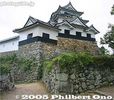
Mar 23, 2007
|
|
|
|

Musa-juku was the sixty-sixth of the sixty-nine stations or shukuba post towns on the Nakasendo Road. It is the seventh Nakasendo station in Shiga (following Echigawa-juku in Aisho). MAPMusa was one of ten Nakasendo stations in Shiga. There is very little left. Near Ohmi Railways Musa Station, a short ride from Omi-Hachiman.Mar 23, 2007
|
|

Hira mountainsMar 23, 2007
|
|

Imazu shoreMar 23, 2007
|
|

Imazu road along the lake shore, near Chojiya inn.Mar 23, 2007
|
|

Kyoto University Rowing Club arrive at Omi-Maiko in Aug. 2006 during their annual Lake Biwa rowing trip.Mar 23, 2007
|
|

Verse 1 Lyrics (Otsu) 一番の英訳(大津). School logo on boat house, a cherry blossom with three stripes for Dai-san Koto Gakko.We're children of the lake, off to wander 'round.
This journey fills my heart with, intense happiness.
Rising mist evaporates, ripples come and go.
Shiga's Miyako dear, bid farewell for now.
われは湖の子 さすらいの
旅にしあれば しみじみと
のぼる狭霧や さざなみの
志賀の都よ いざさらば
Ware wa Umi no Ko, sasurai no
tabi ni shiareba, shimijimi to
Noboru sagiri ya, sazanami no
Shiga no Miyako yo, iza saraba
--
This first verse refers to the start of the journey of life. The lake mist symbolizes the uncertainty of what lies ahead.
The capital of Shiga is Otsu, where they departed from Mihogasaki boat harbor on June 27, 1917. For some reason, the kanji characters for "Shiga" is incorrect for Shiga Prefecture. Mar 23, 2007
|
|

Mar 23, 2007
|
|

Chikubushima is Lake Biwa's most famous, historic, and sacred island. National Historic Site MAPMar 22, 2007
|
|

JR Minami Hikone StationMar 22, 2007
|
|

Viva City, a shopping mall and theater complex near Minami Hikone Station.Mar 22, 2007
|
|

Hachiman Primary School 近江八幡市立八幡小学校Mar 21, 2007
|
|

Hachiman Primary School 近江八幡市立八幡小学校Mar 21, 2007
|
|

In Omi-Hachiman, Shinmachi-dori looking toward Hachimanyama. This area is also a National Important Traditional Townscape Preservation District (重要伝統的建造物群保存地区).Mar 21, 2007
|
|

Worst-looking phallic rock. That's stretching the imagination a little too much.Mar 20, 2007
|
|

Votice tablet with illustration of the Honen Festival.Mar 20, 2007
|
|
|
|

Phallic souvenirs.Mar 20, 2007
|
|

Mar 20, 2007
|
|

Another pair of trees bonded together.Mar 20, 2007
|
|

And another...Mar 20, 2007
|
|

Mar 20, 2007
|
|

Behind the rocks are two trees bonded together.Mar 20, 2007
|
|

Best-looking phallic rock.Mar 20, 2007
|
|

Female and male rocks.Mar 20, 2007
|
|

Mar 20, 2007
|
|

Phallic rock. There are several phallic rocks donated by various people. Apparently they are either natural or carved.Mar 20, 2007
|
|

Put in money and it will make a "chin" sound. (From the word "chinpo" for penis.)Mar 20, 2007
|
|

Rub the two balls.Mar 20, 2007
|
|

Mar 20, 2007
|
|

Phallic fence posts.Mar 20, 2007
|
|

Place to rub the sacred balls. 珍宝窟Mar 20, 2007
|
|

Votice tablets written with people's wishes for love, sex, and babies.Mar 20, 2007
|
|

Mar 20, 2007
|
|

Mar 20, 2007
|
|

Phallic objectsMar 20, 2007
|
|

Apparently it can become erect too. (Compare with previous photo.)Mar 20, 2007
|
|

Mar 20, 2007
|
|

Note that the phallus is not the object of worship. It is an offering to the god.Mar 20, 2007
|
|

Oku-no-miya Shrine. Look carefully and you can see what's inside. 奥宮Mar 20, 2007
|
|

Oku-no-miya Shrine also has many other phallic objects presented as offerings. There even one which you can touch...Mar 20, 2007
|
|

This is what you see inside Oku-no-miya Shrine. A giant wooden phallus offering.Mar 20, 2007
|
|

Stones and Oku-no-miya ShrineMar 20, 2007
|
|

Torii to Oku-no-miya Shrine, next to the Honden main hall.Mar 20, 2007
|
|

Tagata Shrine Honden main hall. Komaki, Aichi Pref.Mar 20, 2007
|
|

Tagata Shrine Honden main hall which worships shrine worships a deity called Tamahime-no-Mikoto who was a daughter of a powerful local lord from the 5th century.Mar 20, 2007
|
|

Mikuji paper fortunes for love and romance, marriage, and childbirth.Mar 20, 2007
|
|

Tagata Jinja-mae Station on Meitetsu Railways' Komaki Line, a few stops from Inuyama Station. The shrine is a 10 min. walk from the train station.Mar 20, 2007
|
|

Tagata Shrine stone markerMar 20, 2007
|
|

Tagata Shrine torii and entrance 田縣神社Mar 20, 2007
|
|
|

LollipopsMar 17, 2007
|
|

Mar 17, 2007
|
|

The bottom of the woman figurine. Naughty, naughty...Mar 17, 2007
|
|

Sake flaskMar 17, 2007
|
|

Senbei crackersMar 17, 2007
|
|

Mar 17, 2007
|
|

Demure-looking woman figurine looks deceiving until you look at the bottom...Mar 17, 2007
|
|

Mar 17, 2007
|
|
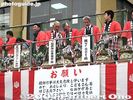
At 4 pm, the festival's final event is the mochi-nage or rice-cake tossing. First, they warn eveyone that the shrine won't be liable for any injury you might incur from this. And the elderly and children should avoid this mochi-nage.Mar 17, 2007
|
|
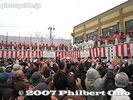
A large crowd tries to catch numerous mochi which are hard and can be dangerous if it hits you on the face or head. To avoid injury, do not look down and don't try to pick up mochi on the ground. You can get trampled, and most injuries occur this way.Mar 17, 2007
|
|

Mar 17, 2007
|
|

The usual penis souvenirs on sale.Mar 17, 2007
|
|

Mar 17, 2007
|
|

Installed inside the shrine's Honden main hall, the new giant penis will replace the old one.Mar 17, 2007
|
|

Ema votive tablet with giant penis portable shrine. 500 yen.Mar 17, 2007
|
|

Pregnant women also attend the festival. As well as mothers with a young baby coming to give thanks.Mar 17, 2007
|
|

Now comes the giant phallus heading for the shrine's main hall.Mar 17, 2007
|
|
|
|

Mar 17, 2007
|
|

Carried by men singing kiyari laborers' songs, the smaller wooden phallus also goes to enter the shrine's main hall.Mar 17, 2007
|
|

Portable shrine for Takeinadane-no-MikotoMar 17, 2007
|
|

Tagata Jinja banners.Mar 17, 2007
|
|

Mar 17, 2007
|
|

Mar 17, 2007
|
|

Tagata Shrine grounds during the Honen Festival.Mar 17, 2007
|
|

Giant phallus makes its way to the shrine.Mar 17, 2007
|
|

The giant phallus in front Tagata Shrine's Honden main hall.Mar 17, 2007
|
|

Palanquin for Deity of HarvestsMar 17, 2007
|
|

Penetration successful. This is 3:30 pm.Mar 17, 2007
|
|

The giant penis also arrives at the shrine as it spins around behind theMar 17, 2007
|
|

The phallus is a symbol for themes of fertility.Mar 17, 2007
|
|

Women spectators touch the penis for good fortune and to become fertile perhaps?Mar 17, 2007
|
|

Portable shrine for Takeinadane-no-Mikoto enters the Honden main hall.Mar 17, 2007
|
|

The standard-bearer with a banner of shunga-style penis painting.Mar 17, 2007
|
|

Sarutahiko-no-OkamiMar 17, 2007
|
|

Mar 17, 2007
|
|

Salt sprinkler enters first.Mar 17, 2007
|
|

Tagata Shrine crowded with people waiting for the procession to arrive.Mar 17, 2007
|
|

Entrance to Tagata Shrine crowded with people waiting for the procession to arrive.Mar 17, 2007
|
|

Mar 17, 2007
|
|

Banner of shunga-style penis painting.Mar 17, 2007
|
|

By this time, all the men are filled with sake and gregarious.Mar 17, 2007
|
|

On the main road.Mar 17, 2007
|
|

Mar 17, 2007
|
|

Finally on the main road to Tagata Shrine. Half the road is blocked off for the procession.Mar 17, 2007
|
|

Mar 17, 2007
|
|

Tagata Shrine crowded with people waiting for the procession to arrive.Mar 17, 2007
|
|

DrumMar 17, 2007
|
|

Mar 17, 2007
|
|

Not sure what this is.Mar 17, 2007
|
|

Sarutahiko-no-Okami, the deity who led the descent of Amaterasu (Sun Goddess) from heaven to earth.Mar 17, 2007
|
|
|

Takeinadane-no-MikotoMar 17, 2007
|
|

Mar 17, 2007
|
|

The first half of the route is quite narrow.Mar 17, 2007
|
|

Salt sprinkler heads the procession to purify the way.Mar 17, 2007
|
|

Portable shrine for Takeinadane-no-MikotoMar 17, 2007
|
|

The route is short, but it's a slow procession with many short breaks. The procession lasts 1.5 hours.Mar 17, 2007
|
|

Also see the video at YouTube. Honen-sai Festival, Tagata Shrine Honen Festival.Mar 17, 2007
|
|

Mar 17, 2007
|
|

Branches of the sacred sakaki tree.Mar 17, 2007
|
|

Maidens who are 36 years old, carry wooden penises for protection during their "unlucky age" (yakudoshi).Mar 17, 2007
|
|

Sake cartMar 17, 2007
|
|

Mar 17, 2007
|
|

Toshi-gami deity of harvests.Mar 17, 2007
|
|

Where the penis goes, the crowd follows.Mar 17, 2007
|
|

Mar 17, 2007
|
|

Toshi-gami deity of harvests is pulled on a palanquin instead of being carried.Mar 17, 2007
|
|

The giant phallus by itself weighs about 280 kg (620 lbs.). The total weight of both the phallus and portable shrine housing is 400 kg (885 lbs.).Mar 17, 2007
|
|

Next is a palanquin (not mikoshi) for the Toshi-gami deity of harvests. 御歳神Mar 17, 2007
|
|

They spin around the phallus.Mar 17, 2007
|
|

The second mikoshi features the giant penis carried by 12 men at a time, all of whom are age 42, considered to be an unlucky age (yakudoshi) for men. They seek protection by carrying the phallus.Mar 17, 2007
|
|

Takeinadane-no-MikotoMar 17, 2007
|
|

The procession goers down the slope in front of Kumano Shrine.Mar 17, 2007
|
|

Sarutahiko-no-Okami, the deity who led the descent of Amaterasu (Sun Goddess) from heaven to earth.Mar 17, 2007
|
|

Mar 17, 2007
|
|

People waiting for the procession in front of Kumano Shrine.Mar 17, 2007
|
|

Men in happi coats which read "Honen Matsuri." Honen literally means "year of abundant harvest."Mar 17, 2007
|
|

The giant phallus is called "O-owasegata." It is an offering, and not a deity nor object of worship. Tagata Shrine Honen Festival. A total of 60 men take turns carrying the giant phallus portable shrine. 大男茎形Mar 17, 2007
|
|

People waiting for the procession in front of Kumano Shrine.Mar 17, 2007
|
|

Breaking the sake barrelMar 17, 2007
|
|
| 71466 files on 284 page(s) |
 |
 |
240 |  |
 |
|